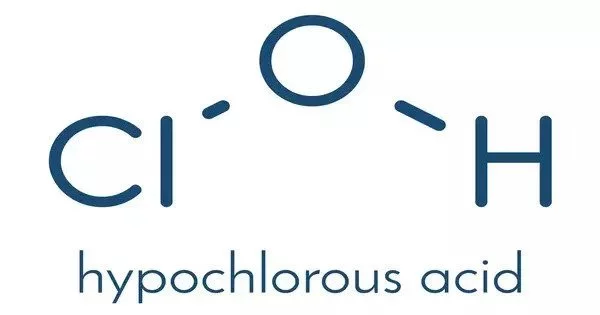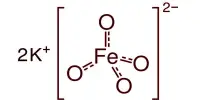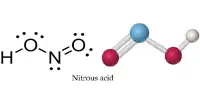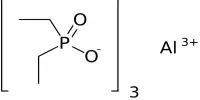Hypochlorous acid (ClOH, HClO, HOCl, or ClHO) is a weak acid formed when chlorine dissolves in water and partially dissociates to form hypochlorite, ClO. HClO and ClO are oxidizers and the primary disinfectants in chlorine solutions. Because of its rapid equilibration with its precursor, chlorine, HClO cannot be isolated from these solutions. It is commonly used in healthcare settings, water treatment facilities, and in household cleaning products.
Properties
Hypochlorous acid is a colorless, unstable liquid at room temperature. It is usually stored and used as a dilute aqueous solution. Because of their strong antimicrobial properties, the related compounds sodium hypochlorite (NaClO) and calcium hypochlorite (Ca(ClO)2) are used in many commercial bleaches, deodorants, and disinfectants.
- Molecular Weight: 52.46 g/mol
- pH: It is a weak acid and exists primarily in its molecular form at a pH below 7. As the pH increases, it ionizes to form the hypochlorite ion (OCl-).
- Oxidizing Agent: It is a strong oxidizing agent. It readily donates oxygen atoms to react with other substances, thereby oxidizing them.
- Stability: It is relatively unstable and can decompose over time. It is sensitive to factors such as light, temperature, and pH.
Disinfectant Properties
Hypochlorous acid is a powerful disinfectant and antimicrobial agent. It is highly effective against a wide range of microorganisms, including bacteria, viruses, fungi, and spores. It works by damaging the cell membranes and proteins of these pathogens, leading to their inactivation.
It is considered biocompatible and non-toxic when used at appropriate concentrations. It is widely used in healthcare settings for wound irrigation, disinfection, and as a cleaning agent. It is also used in food processing, water treatment, and various industries.
Production
HOCl kills a wide variety of microorganisms, including bacteria, viruses, and fungi. It works by disrupting the cell walls and membranes of these pathogens, causing them to die. In comparison to other disinfectants, hypochlorous acid is considered safe for use because, when used properly, it is non-toxic to humans and animals.
Electrolysis, chemical reactions, and the use of specialized generators are all methods for producing hypochlorous acid. It is frequently used in healthcare settings as a disinfectant to sterilize surfaces, medical equipment, and instruments. It is also used in water treatment to remove bacteria and other microorganisms, ensuring that drinking water is safe.
Applications
Hypochlorous acid is used in a wide range of industries, including healthcare, sanitation, food processing, agriculture, and water treatment. It is used in a variety of settings for surface disinfection, wound care, oral hygiene, deodorization, and microbial growth control.
Hypochlorous acid is a less harmful to the environment than traditional chlorine-based disinfectants. It degrades into harmless byproducts such as water and salt and does not contribute to the formation of potentially harmful chlorinated organic compounds.















